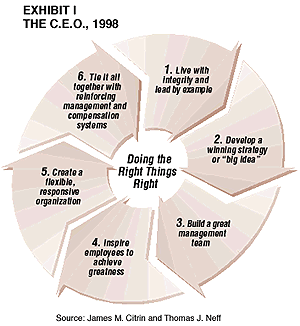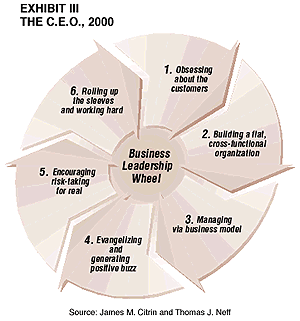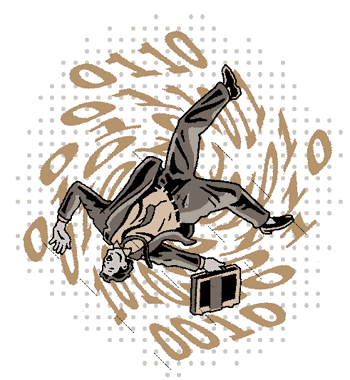Digital Leadership
Spencer Stuart unveils "Talent.com," a study of essential C.E.O. qualities in the New Economy.
If Wolfgang Amadeus Mozart and Elton John traded their places in history, would Mozart have become the biggest rock star of our day? Would Elton John have been the greatest composer of all time? Both men were blessed with perfect musical pitch, a prodigious work ethic, spectacular manual dexterity and a driving ambition. However, while one composed "Eine Kleine Nachtmusik" and charmed the royal courts of Europe in the late 1700's, the other wrote "Candle in the Wind" and played to sellout crowds in Madison Square Garden.
What about Jack F. Welch Jr., the legendary chairman of the General Electric Company, and Jeff Bezos, founder and chief executive officer of Amazon.com Inc.? Would they be as successful if they found themselves in each other's shoes? In both cases, our answer is "yes."
Musical experts agree that the inherent qualities that make artists great are as relevant today as they were in Mozart's time. So too would we argue that the fundamental characteristics that make for outstanding business leadership are as applicable for the New Economy as they were in the Industrial Age. However, just as Elton John enhances his music with digital effects and produces music videos for VH1, business leaders must adapt to today's realities. Digital leadership demands living by the enduring principles that make for success, and augmenting them with new qualities that enable speed, flexibility, risk-taking, an obsession with customers and new levels of communication inside the organization.

Our views on leadership in the New Economy are based on research conducted for our recent book "Lessons From the Top" (Doubleday, 1999), our casework at Spencer Stuart, where we work with clients to recruit top management teams, and "Talent.com," an ambitious survey of the impact of the Internet on leadership development, organizational structure and culture. For this survey, a team of Spencer Stuart consultants interviewed top executives from more than 55 companies nationwide at different stages of Internet deployment. Survey participants ranged from Amazon.com, DoubleClick and eToys, to Federal Express, Sony and Kodak.
Business leadership can be distilled into the phrase "doing the right things right." When leaders succeed in doing the right things - both personally and within their organizations - the traditional measures of success inevitably follow. There are six fundamental and mutually reinforcing principles that the most successful business leaders follow, which are as relevant today as they were in earlier environments. The best image to help keep these principles in mind is a wheel - with each principle naturally leading to the next. We call this image the "business leadership wheel." (See Exhibit I.)
Does the business leadership wheel apply as well in the New Economy as it does in more traditional enterprises? Let's take a look at two leaders, one acclaimed as the "Manager of the Century" by Fortune magazine and the other credited with nothing less than pioneering the consumer e-commerce revolution. (See Exhibit II.)

G.E. and Amazon.com are market leaders in large part because Jack Welch and Jeff Bezos follow the enduring principles of leadership, and tailor them to each company's situation. It is no wonder, then, that in Spencer Stuart's "Talent.com" survey, Mr. Bezos was the leader most highly regarded in the Internet industry, and Amazon.com was the company highest-rated for attracting, developing and retaining executive talent.
If you lined up the other most successful Web-centric leaders, such as Timothy Koogle of Yahoo, Meg C. Whitman of eBay, John T. Chambers of Cisco Systems and Michael S. Dell of Dell Computer, and compared them with the best leaders from traditional companies, such as Bill Marriott Jr. of Marriott International, Kenneth L. Lay of Enron, and Hank Greenberg of A.I.G., you would find the same strengths across each of the six leadership principles.
Equally important, in each case the best leaders - whether in traditional businesses or the Digital Economy - apply these principles consistently; there are no contradictions. In an individual, this kind of consistency is often described as "walking the talk." Within a company, it is typically called "executing on strategy." The lesson is the same in either case: The greatest success is achieved when a leader is consistent, when the organization is consistent, and when this consistency is linked to what the company stands for and how it behaves. Conversely, when the principles are not followed - whether in an established company or at an Internet startup, success will not follow.
This point was reconfirmed recently when a board member of one of the nation's best-known public Internet companies paid us a visit to discuss the potential need to recruit a chief operating officer. The company and the stock price had been doing well by traditional performance measures, but employee morale was sinking and turnover was accelerating. As a diagnostic, we looked at how the C.E.O. did or did not follow the six "do-the-right-things-right" principles.

We found major gaps. There was an outstanding strategy for building Web traffic and providing customers an exceptional value proposition within a viable business model. There were heavy stock options and incentive programs to reinforce behavior and support the strategy. However, the C.E.O. did not inspire employees because he did not lead by example, was not consistent and was a poor communicator. And the company was starting to be outmaneuvered by competitors because all decisions were being forced through the C.E.O. - the company was not set up to be a flexible, responsive organization. We suggested that the board coach the C.E.O. using the business leadership wheel as a tool. The board is now doing so, with early success, but if the gaps cannot be filled, the board will be forced to take serious remedial action.
If success in the Digital Economy demands living by the enduring principles and augmenting them to create speed, risk-taking and flexibility, what specifically should an individual keep in mind as he or she seeks to lead the organization? The detailed interviews with top Internet executives in our "Talent.com" survey, along with our recruiting work, prompt us to conclude that there are, in fact, six "new principles" to add to the mix. Think of them as a second Business Leadership Wheel. (See Exhibit III.) Success in the Digital Economy will be achieved when a leader focuses on doing the right things right, and doing so in a turbocharged way.
The six augmented qualities of leadership in the Digital Economy follow.
1. OBSESSING ABOUT THE CUSTOMER
All companies need to be focused on creating winning customer propositions. After all, no business can succeed without customers.
In the traditional corporation, marketing management typically engages a market-research firm to conduct surveys and focus groups and to pass reports back to brand management, which uses the information to enhance current products and design new products. The process often takes three to six months.
In the Digital Economy, this process must be accelerated dramatically and must reside at the very top of the C.E.O.'s priority list. Customer obsession is a critical leadership characteristic in today's world. Why? The Digital Economy inverts the traditional relationship between the company and the customer. Fragmenting markets and the increasing marketing costs necessary to create breakthrough brands raise a firm's customer-acquisition costs. At the same time, Web-based commerce dramatically lowers a customer's cost in seeking out and switching suppliers. This gives the customer far more power - and the enterprise far less - than in the Industrial Economy. Exacerbating this dynamic are the high stakes; the sky-high valuations of Internet companies are often based on the number of registered customers.
One of the best examples of customer obsession is The Motley Fool, the financial-advice Web site and community. The company has almost two million registered users and the site has an extremely high degree of "stickiness" - the average time per customer visit is over a half-hour. Beyond delivering an audience to support the advertising revenue stream, this loyalty is critical for the "viral marketing" that helps Web-based businesses grow market share. In companies like The Motley Fool Inc., passionate customers - "fools" in the company's parlance - become your sales force.
A highly involved community also becomes an avenue for enhancing service and increasing customer satisfaction through immediate feedback loops that can be constructed between customers and the company. Motley Fool founders Tom and David Gardner, for example, consider listening to customers a principal strategy for developing new aspects of their service. "Our community is really our R&D lab," they told us. "We recently noticed that a tremendously vibrant chat area on fool.com was the whole area of home ownership. As a result, we are planning new books, areas on the site and services for home buying and financing."
As the Motley Fool shows, customer obsession can enable lightning-fast product development, a critical competitive differentiator in the Digital Economy. For most Web businesses, the "product" is as much the content and functionality that customers experience on a company's site as it is the goods the site actually sells.
Underlying the rapid product development is the fact that the vast majority of input into new services on the Internet consists of intellectual capital. The best Internet companies create new product versions continuously. In the 1998 Christmas season, Amazon.com sold only books, music and videos. In the 1999 holiday season, it added toys, electronics, tools and building supplies, auctions and electronic greeting cards, plus links for drugstore items and pet supplies. By contrast, even an offline company renowned for its rapid product replacement cycles, the Gillette Company, typically takes three years to bring a new product to market.
2. BUILDING A FLAT, CROSS-FUNCTIONAL ORGANIZATION
Over the past five to 10 years, the command-and-control style of management that was the rule in the Industrial Economy, a style characterized by centralized decision-making and resource allocation, has given way to greater organizational flexibility. Jack Welch has emphasized that "the key to organizational success going forward will be to have the right person solving the most important business problems, no matter where they are located in the company hierarchically, organizationally or geographically. This mandate, which Mr. Welch calls "the Power of Informal," holds equally true in the Digital Economy. One of the most important ways to make it a reality is to have employees working together across functional disciplines, and insuring that they have the information they need and the authority to make decisions.
Contrary to conventional wisdom, however, a company does not have to be a pre-I.P.O. dot-com to create new organizational approaches. Take the case of Time Warner Inc. The company had two highly publicized, ill-fated attempts to develop major interactive businesses, the Full Service Network in Orlando, Florida and the Pathfinder Internet portal. Although the first failed and the latter was derided by senior corporate managers as a financial "black hole," C.E.O. Gerald M. Levin persevered and stated publicly in mid-1999 that transforming the world's largest media and entertainment company to take advantage of the potential represented by the Internet was (along with his own succession) one of his two top priorities before his planned retirement in 2002. Recovering from two major false starts has not been easy, especially in a company famous for its powerful and autonomous operating divisions. But Mr. Levin made innovative organizational moves that have laid the groundwork for the company's success in the New Economy. First, he appointed the company's highly regarded chief financial officer, Richard Bressler, chairman and C.E.O. of a new entity, Time Warner Digital Media, to house the company's digital businesses. Secondly, he gave the unit the mandate to design and implement new approaches of working across the organization, in whatever way necessary.
Mr. Levin did not pretend to have all the answers up front or wait to figure them out before launching the business. He gave the directive and empowered the operating groups to work it out. He also chartered the group to go outside the company to build the business. This outside reach can take different forms, from outsourcing technology, to making venture investments or acquisitions, to recruiting top talent. So far, Time Warner Digital Media has acquired CDnow Inc., recruited stars into key positions from inside the company, such as William A. Burke, formerly president of TBS Superstation, and from the outside, such as Olaf Olafson, formerly president of the Advanta Corporation and Sony Interactive Entertainment Inc. By making the Internet a top corporate priority and enabling new and effective organizational approaches, Mr. Levin helped create a proposition for attracting top talent into the company and for maximizing its chances of success.
"Try to keep the organization consistent with the Web analogy that something should never be more than three mouse-clicks away," says Jeffrey M. Killeen, chief executive officer of Forbes.com and former chief operating officer at Barnesandnoble.com L.L.C. "We don't want any employee to be more than three levels away from any other. With the 500 to 700 employees at Barnesandnoble.com, that implied 15 direct reports for me, which can be difficult and stressful. But it requires, by definition, everyone to be close to the business."
3. MANAGING VIA BUSINESS MODEL
Developing and maintaining a winning strategy is an essential element of business leadership in all companies. What is different for leadership in the New Economy? The strategy development process.
Strategic planning as a management tool has evolved over the past several decades to help companies set objectives, assess challenges and opportunities, and develop business plans. The result is typically an annual planning cycle in which capital is allocated, budgets are constructed, organizational charts are designed and work plans are committed to. One of the companies best known for its rigorous strategic planning process is the Emerson Electric Company, the St. Louis-based electrical products and electronics equipment manufacturer that has produced a record 41 consecutive years of increasing earnings per share. Chuck F. Knight, C.E.O. of Emerson for the past 26 years, credits "the management process," as it is known in the company, for providing the framework for setting goals, agreeing on directions and holding people accountable. In the Digital Economy, however, strategy development must be much more fluid. Businesses are inherently more integrated in the Digital Economy than in traditional industries. Web sites are linked, traffic moves fluidly from site to site, and business development teams negotiate ferociously for the best placements on highly trafficked sites. As a result, a supplier may become a competitor one day, a marketing partner the next day, and an acquisition target soon after that.
An example of this is Real Networks Inc., the Seattle-based audio- and video-streaming company founded by Robert Glaser, formerly a senior executive at the Microsoft Corporation. The company became a direct competitor with Microsoft when the Redmond giant decided to develop streaming media as a service to add value to its Internet Explorer product. But Microsoft (as it has often done with other promising technology companies) also acquired a 10 percent stake in Real Networks, giving both sides the option of expanding the partnership. As it turned out, Mr. Glaser determined that the business model was more compelling with Real Networks as an independent company than as a partner of Microsoft. Yet while the companies have remained archrivals, they continue to cooperate at some levels, a tenuous dance that has enabled Real Networks to maintain its large lead in the marketplace.
The point is that relationships are much more fluid and multidimensional in the Digital Economy. As a result, rather than manage via a detailed annual strategic planning process, the best digital leaders manage via a strategic framework, or business model. In the Internet Economy, every major decision can be evaluated as a scenario and approached from all angles. Should we build or buy? Acquire or enter into a joint venture? License or sell?
As Tom Evans, formerly chief executive officer of GeoCities and now C.E.O. of Official Payments Corp., told us, "Each alternative needs to be put through our business model. Speed is not to be confused with winging it. People can't just go off creating deals without an understanding of how they fit into the whole. We need to be incredibly decisive in a short amount of time without all of the information. The key is to create a rapid analytical decision-making process that prioritizes our choices to come up with the right answers."
A top executive at eToys Inc. added, "It's important to be flexible as the medium matures, so that the company can adjust to market changes. Scenario planning, as opposed to traditional planning processes, will increasingly be important. People have to assimilate information and changes in business constructs quickly, and be able to grasp and run with the new constructs."
4. EVANGELIZING AND GENERATING POSITIVE BUZZ
C.E.O.'s have always had to communicate effectively with employees. But more than ever before, they have to understand and be able to relate to the media, institutional investors, Wall Street analysts, suppliers, and even alliance partners and acquisition candidates.
In an environment where profits and, for that matter, revenues are still hard to come by, evangelizing the company and generating public-relations buzz is a first step to success. Often, the initial investment criterion of venture capitalists is the ability of the entrepreneur to communicate the company's opportunity and generate confidence. After the initial public offering, the ability of the C.E.O. to generate continued enthusiasm in the financial community undergirds the extraordinary market valuations that support the Digital Economy. Today, an e-company's market capitalization is much more than the aggregated discounted cash flows from the business; stock price and market capitalization generate ongoing interest among investors and media, and ultimately drive customer traffic to the business or Web site.
Overseeing a brand's image also has become more of a C.E.O. function today than it ever was before. As Frederick W. Smith, founder and C.E.O. of FDX Corp. (and its Federal Express unit) told us, "Today, being a great C.E.O. means being a great communicator." Charles R. Schwab, founder, chairman and co-C.E.O. of the leading online brokerage firm, added, "A majority of my and my co-C.E.O. Dave Pottruck's time nowadays is spent on communicating our vision and insuring that all parts of our company are in alignment."
The role of the trade press and the general business press in creating a C.E.O.'s profile cannot be underestimated. Venture capitalists, employees, strategic partners and professional services providers all want the same thing: to be associated with the next Amazon.com, eBay or Yahoo. Since a lot of the perceptions are created by generating P.R. buzz, C.E.O. celebrity is now more important than ever. Jeff Bezos has been profiled in countless business magazines. Yahoo's Mr. Koogle, eBay's Ms. Whitman, CMGI's David Wetherell, and DoubleClick's Kevin J. O'Connor have all similarly broken through the crowd to become high-profile magnets for their companies.
5. ENCOURAGING RISK-TAKING FOR REAL
It is easy to say that a company should encourage intelligent risk-taking. After all, trying new things and adapting based on results have forever been the cornerstones of innovation. In the Digital Economy, however, where barriers to entry are low and the rewards for success huge, new approaches need to be invented continuously to stay ahead. In the trial-and-error Internet culture, where capitalizing on customer feedback loops is a key to success, leaders need to make risk-taking a reality, not just talk.

Let us illustrate this principle with a current case study. Spencer Stuart recently spent time on a confidential organizational diagnostic and recruiting strategy session with a major global financial services organization, one with more than 10 million customer accounts. The firm, known for its conservative corporate culture, managed to get an Internet initiative developed and out into the market to become an early leader in online banking. As is often the case, the initiative's costs were higher and customer growth slower than planned. Rather than take the learning that the team had garnered and adapt the service to meet evolving customer needs, however, the bank's top management team launched an audit into the project. Internally, the project quickly became known as a loser for missing the target. The project manager and the project team have had their wings clipped, and the project is being scaled back.
At the same time, the bank's competitors are accelerating their move into the space. Now, as senior managers debate their Internet strategy, they also lament the fact that competitors are raiding their team and they cannot successfully recruit new talent. Our advice was not to go out and recruit new people, but to reassess the messages management was sending to the company about trying new things and missing targets.
By contrast, when GeoCities was undergoing a reorganization, then-C.E.O. Tom Evans took pains to encourage idea generation without regard for the risk implied for each employee. "The key to making the reorganization work was to eliminate the people-posturing," he said. "The way we did that was to put ourselves into a room and say, 'Don't worry, at the end of this process, every single person in this room will come out a vice president of something. O.K?' So people therefore knew that they didn't have to put their own interests ahead of the organization's. We reduced the risk to each of the participants, and the company's ability to adapt to ongoing changes improved."
6. ROLLING UP THE SLEEVES AND WORKING HARD
With equity-based compensation packages for Internet C.E.O.'s reaching into the hundreds of millions of dollars, executives across America are wondering what it requires to take the plunge and succeed. The principles outlined above are only part of the answer; they won't make a difference unless a candidate is willing to enter the fray and work Internet hours at Internet depth.
By necessity, C.E.O.'s of large corporations spend the bulk of their time working through others, often listening to well-rehearsed presentations in large group meetings. They typically go back to the office to make decisions and set direction, frequently with the benefit of substantial staff work. As Ralph Larsen, chairman and C.E.O. of Johnson & Johnson, told us, "By the time any decision reaches this office, there are no longer 'right' or 'wrong' answers; there are just shades of gray." He therefore applies his seasoned judgment to the staff work and makes decisions.
This contrasts markedly with leaders in early-stage Internet companies. Take the case of eBay's Meg Whitman. Having joined the company in 1998 from senior roles at Hasbro, FTD and Disney, she knew something about corporate decision-making and support. Moving to an Internet startup required her, though, to look less at the management styles of senior executives at such companies and more at the work styles of their subordinates. "There really is nothing that complicated about defining what it takes to successfully move from a large corporation to a dot-com," Ms. Whitman told us. "All you have to do is think back to what your first job was like after school, where you had to do everything and you didn't have all the corporate support staff. That's what it was like for me the first year. If you are really willing and able to do that again - crunch your own numbers, write your own presentations, book your own travel - you can be an effective Internet executive."

Leaders in the Digital Age also work longer hours than those in traditional companies. The 50 C.E.O.'s in our book "Lessons From the Top" work an average of 65 hours per week. While greater than the C.E.O. workweek in times past, this is still substantially below the estimated 75 to 80 hours per week that the C.E.O.'s in our "Talent.com" study work.
A lot of the extra hours derive from the hierarchy-flattening power of new technologies. After stints as president and C.O.O. of Starwood Hotels & Resorts Worldwide Inc. and as C.F.O. at the Walt Disney Company, Richard Nanula recently became the new chairman and C.E.O. of Broadband Sports Inc., the Los Angeles-based Internet company that runs the Athlete Direct group of 250 top-athlete Web sites. "Our C.F.O. and founder are right next door to me," he told us. "But when they want to tell me something, they e-mail me. This is quite a change! I'm online all night long and all weekend long now."
He is also deeply fulfilled in his new work and his new life - a fact that has relevance across executive suites. For just as the qualities of Industrial-Era leadership are still necessary for leadership in the Internet Economy, so too are the new principles of digital leadership requirements for managers in all companies today. History shows, after all, that breakthrough technologies - whether electricity, mass production or the Internet - quickly spread their effects across the rest of the economy. Successful leaders adapt with equal rapidity. Mozart, we feel sure, would have adapted his talents to Elton John's environment. Jack Welch, a mere three years away from retirement, did adapt himself to the world of Jeff Bezos. The key to digital leadership is to do the right things right and to turbocharge the original leadership principles by focusing on the new qualities that enable speed, flexibility and customer focus.
FOCUS: CHASE.COM
Banking on a Culture War
By Glenn Rifkin
The Chase Manhattan Corporation, the nation's third-largest bank, poured $100 million into Internet activities in 1999 and plans to double that in 2000, a not-insignificant sum, even for a global financial institution with nearly $400 billion in assets and $13 billion in annual technology spending. But for Joseph G. Sponholz, the most daunting obstacle to the "dot-comming" of Chase Manhattan is not the technological challenge - it is changing the corporate culture of the massive bank and its 76,000 employees. A vice chairman of Chase and head of its new Internet business unit, Chase.com, Mr. Sponholz knows he faces pockets of internal resistance to the accelerated Internet transition.
If a bank's top management "doesn't get it and doesn't respond" to the new Internet environment, it will hear the death knell soon enough, Mr. Sponholz says. Chase's management, he insists, "gets it," which is a huge advantage in itself. One indicator of the bank's willingness to shake up corporate culture was new C.E.O. William B. Harrison's mandate to create Chase.com in 1999. The new business unit has 65 employees and is decidedly unbanklike. Housed in its own location in Manhattan, the new unit is characterized by casual dress, an "anti-hierarchical"working environment built around teams, and stock options to lure new talent.
For Mr. Sponholz, the task started at the top. He immersed Chase's senior executives in discussions about the Digital Economy, which spawned a series of initiatives designed to cascade awareness down into the rest of the bank. An Internet leadership council was formed, chaired by Mr. Harrison and two vice chairmen. Every business unit inside Chase now has a senior executive responsible for Internet management and initiatives. And to emphasize the bank's commitment to e-commerce, Mr. Harrison created Chase.com as the locus of Internet activities within the bank. "When the C.E.O. says 'this is the single highest priority we have,' that creates a lot of excitement and attention. People want to be part of that," Mr. Sponholz says.
Chase has several powerful business advantages in the Internet wars. With 32 million customers, it has a larger consumer base than America Online. Such numbers attract Internet entrepreneurs, who regularly pound on Mr. Sponholz's door with ideas for joint ventures. In addition, the bank has a vast internal network of intellectual capital that can be reconceptualized online.
But Mr. Sponholz, 55 years old and a 22-year banking industry veteran, knows that unleashing intellectual capital - indeed, reconceiving the role of a bank in the 21st century - remains an arduous cultural task. "We are all control freaks because good controls are a tenet of a banker's faith," he says. "So we all sign off on everything, all the way up the pyramid, which just about guarantees that genuine innovation and experimentation rarely happen." But Chase.com is breaking the rules to reinvent its approach to banking. ![]()
Reprint No.00105




